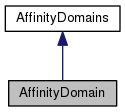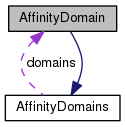 |
LIKWID
|
 |
LIKWID
|
The AffinityDomain data structure describes a single domain in the current system. More...
#include <likwid.h>


Public Attributes | |
| uint32_t | numberOfCores |
| Number of CPU cores in the domain. | |
| uint32_t | numberOfProcessors |
| Number of HW threads in the domain and length of processorList. | |
| int * | processorList |
| List of HW thread IDs in the domain. | |
| bstring | tag |
| Bstring with the ID for the affinity domain. Currently possible values: N (node), SX (socket/package X), CX (LLC cache domain X) and MX (memory domain X) | |
 Public Attributes inherited from AffinityDomains Public Attributes inherited from AffinityDomains | |
| AffinityDomain * | domains |
| List of all domains in the system. | |
| uint32_t | numberOfAffinityDomains |
| Number of affinity domains in the current system and length of domains array. | |
| uint32_t | numberOfCacheDomains |
| Number of LLC caches in the system. | |
| uint32_t | numberOfCoresPerCache |
| Number of HW threads per LLC cache in the system. | |
| uint32_t | numberOfNumaDomains |
| Number of NUMA nodes in the system. | |
| uint32_t | numberOfProcessorsPerCache |
| Number of CPU cores per LLC cache in the system. | |
| uint32_t | numberOfProcessorsPerSocket |
| Number of HW threads per socket/package in the system. | |
| uint32_t | numberOfSocketDomains |
| Number of CPU sockets/packages in the system. | |
The AffinityDomain data structure describes a single domain in the current system.
The AffinityDomain data structure describes a single domain in the current system. Example domains are NUMA nodes, CPU sockets/packages or LLC (Last Level Cache) cache domains.
 1.8.11
1.8.11